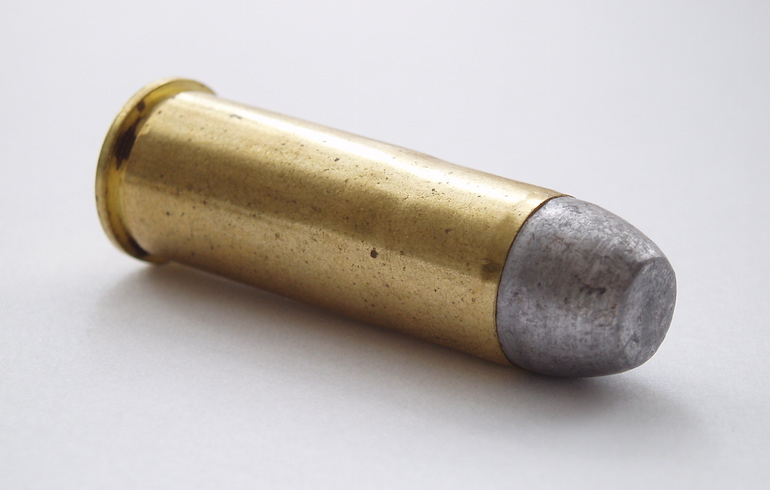In 1847 a Paris gunsmith, B. Houllier, patented the very first cartridge, efficient in being fired by the blow of the weapon's hammer. In one type, a pin was driven into the cartridge by the hammer action; in the other, a guide charge of fulminate of mercury was taken off in the cartridge rim.

In 1847 a Paris gunsmith, B. Houllier, patented the first cartridge, efficient in being fired by the blow of the weapon's hammer. In one type, a pin was driven into the cartridge by the hammer action; in the other, a guide charge of fulminate of mercury was blown up in the cartridge rim.
What was required was a self-contained cartridge with the guide, powder & bullet all in one neat and weatherproof unit. An early effort at this was the pinfire system, initially introduced around 1846, in which a shooting pin was installed on each copper cased cartridge, firing up an internal primer when struck by the gun's hammer.
The Buzz on How The Rifle And Handgun Fire
Possibly more important than the revolver was the cartridge it fired. When the shooting pin of the revolver's hammer struck the rim of the cartridge, the priming fired up the powder, shooting the bullet, leaving the empty copper case in the chamber.
Check out this additional data at my roommate's site!
Opinions are those of the author and not necessarily those of NRA or the National Firearms Museum. Initially published in "Weapons.".
Acquire more analysis at this webpage.
In the early years the race was to produce little arms ammo with just adequate power to hit the enemy and do some damage. This altered sometime in the 1800s when the very first recognizably "modern-day" ammo appeared. As I pointed out in my article on body armor, this is partially since ever more powerful rounds have actually been needed to permeate protective equipment.
To understand small arms ammo of the modern-day period we initially require to look back at where it all began. Whilst a cannonball can technically be called "ammunition", I suppose, the first really integrated types of little arms ammo date to the 1500s.
In theory the paper was expected to be discarded, but in practice most soldiers utilized it as wadding to enhance the power of their weapon. That, priming powder still required to be put into the barrel, as the primary charge was not volatile sufficient to fire up on its own.
Calibers & Bullets 101 Can Be Fun For Anyone
In the early years of the percussion cap, however, some engineers recognized an issue. The new rounds were surrounded by a metal case that held the priming powder and propellant together. This case had actually to be ejected from the rifle before a brand-new round could be packed, complicating the system of these guns.
Some developed complicated ejection gadgets, but these were susceptible to jamming. Some said that "self-consuming" cartridges must be used, which ruined the cartridge case when it was fired - but these also shown inefficient. In the end, the agreement was the advantages of metal cases surpassed the occasional jamming issues - and it is this style that is still used for little arms ammunition.
The first was given that all elements of ammo were contained within a single system they might be produced away from the battleground- triggering the ammo industry we see today. The second benefit was that the brand-new cartridges had a case which expanded as the round was fired. This stopped hot gases from leaving backwards through the breech of the weapon, decreasing wear on the weapon and enhancing power at the same time.
Little Known Facts About Understanding The Basics Of A Firearm Cartridge Or Bullet.
In the early years of the war soldiers usually depend on their own, muzzle-loading guns. Nevertheless, by 1864 the Sharps rifle, a breech-loading rifle that used incorporated cartridges, was being issued to soldiers on both sides of the war. In addition, throughout the war Smith and Wesson produced the first revolvers, at first as side-arms for cavalry troops.
It was the very first all-metallic cartridge to end up being popular, and therefore forms the basis of numerous modern-day rounds. 1857 saw the arrival, finally, of a cartridge that we are still utilizing today.
In basic, no great strides were made in the way in which bullets were created or made, one clear story is discernible in the 20th Century. Cartridges became increasingly more effective throughout the Century. The World Wars of the early part of the period resulted in armed forces embracing ever more powerful rounds for small arms, and the increasing efficiency of body armor suggested more power was needed to get targets.
Firearm Basics - Parts Of A Cartridge Fundamentals Explained
The process perhaps culminated in the development of the 7. 6251mm NATO round in the 1950s. Presented initially in the M14 gatling gun, it was later embraced by armed forces all over the world as the standard full-power attack rifle round. The 7. 62mm represented the limit of what soldiers could be anticipated to carry in the field, and was therefore constantly a compromise between power and mobility.